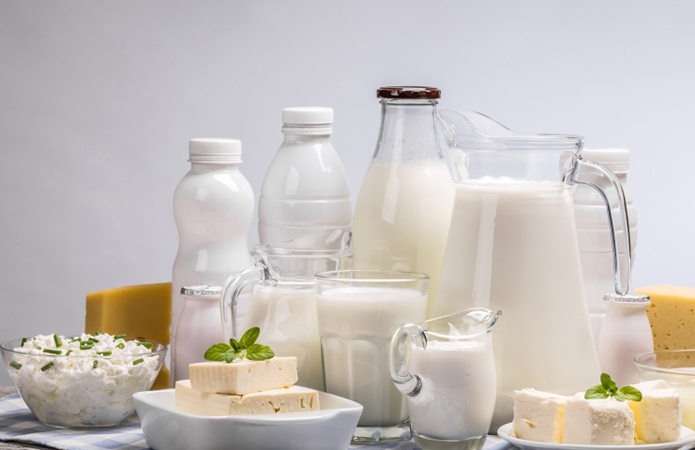India’s dairy sector remains strong and steady

India is one of the major producers of milk in the world and while its population accounts for most of the consumption of the nation’s produce, there is no doubt that production is standing strong with a steady growth in the volume over the years.
According to market data firm, Statista, the dairy industry over the years has evolved to include an array of products. Butter, paneer (an Indian cheese), curd and yoghurt are the building blocks of the processed milk products industry in India. However, in the organised market, butter and cheese dominated the dairy market.
6 major milk producing states
- Uttar Pradesh (16.3%),
- Rajasthan (12.6%),
- Madhya Pradesh (8.5%),
- Andhra Pradesh (8.5%)
- Gujarat (7.7%)
- Punjab (6.7%)
Together they accounted for 60% of total milk production in Indian Fiscal Year (IFY) 2018/2019 (April-March). Also, the per capita availability of milk in India was estimated at 394 grammes/day (national average).
Milk production
The 2019 Livestock Census says that the milch cattle population of exotic breeds and cross-breeds has increased by 32% over the last Census (2012). Which has significantly contributed to overall milk production: those breeds have higher milk yield of 7.95 kg/cow against 3.01 kg/cow for indigenous breeds.
The state of West Bengal now leads the cattle population (9.85%) in India, followed by Uttar Pradesh (9.7%), Madhya Pradesh (9.7%), Bihar (7.9%), Maharashtra (7.2%) and Rajasthan (7.2%). The 6 states together constitute 50% of India’s total cattle population (20th Livestock Census), the USDA reported.
An estimated 49% of India’s milk production originates from water buffalo (35% indigenous buffalos and 14% nondescript buffalos (ones which are not selected or bred for productivity). Uttar Pradesh has the heaviest concentration of buffalo population at 33%, followed by Rajasthan (12.4%), and Madhya Pradesh (9.5%). Because of the higher fat content in the milk of water buffaloes, some farmers prefer these animals as with the high fat content an increased price can be fetched at market.
Trade and consumption
India exports SMPs regularly to countries such as Bangladesh (the largest buyer), Afghanistan, Malaysia, Pakistan, and UAE. Total butter exports in 2020 were expected to rise from 50,000 MT in 2019 to 55,000 MT, due to modest demand from traditional and new buyers. Principal buyers include Egypt, UAE, Saudi Arabia, Australia and the United States of America.
The USDA further adds that India’s major dairy product imports include milk powder, fats and oils, casein, butter, whey, cheese, and lactose. Historically, India has only imported milk powder and butter in limited quantities when it was apparent that domestic production was insufficient or to help control inflation.
Last year on 1 February 2020, the Finance Minister Nirmala Sitharaman presented the Government of India’s (GOI) annual budget for Indian Fiscal Year (IFY) 2020/21. The GOI, with immediate effect, increased tariffs on several food and agricultural products, including dairy products. Basic import duty on butter, ghee and butter oil (HS Code 0405) has been raised from 30% to 40%.
The demand for ghee (clarified butter) and butter, is still robust (ghee is one of the most consumed value-added dairy products). With the growth in middle and high income consumers there is a surge in demand for fermented dairy products such as yoghurt, yoghurt drinks, processed cheese, cheese (e.g., mozzarella, spread, flavoured and spiced), and ice-cream demand is also gaining momentum. Increasing disposable incomes, urbanisation, changing lifestyles, dual income households, and other demographic shifts are driving the demand for processed or value-added dairy products.
Milk safety
Due to the issues and concerns when it comes to milk safety and quality there is a strong push and demand for packaged, ultra-high temperature (UHT) milk. The USDA report further adds that private and cooperative dairies do not have separate collection systems for cow and water buffalo milk, which means that packaged milk product is mostly a mix of the 2 and just a handful of processors market pure cow milk.
The collection of milk from predominantly small-sized dairy farms in India is a huge challenge and still requires investment in infrastructure and procurement systems. However there are plans in place to make adjustments to the current issues with food safety in this regard. India’s government (GOI) has rolled out a programme to maintain milk quality in order to secure food safety at the farm and village level, a scheme is titled, “Strengthening Infrastructure for Quality and Clean Milk Production”. In addition, GOI’s Ministry of Food Processing Industries also provides subsidies to the private sector and dairy cooperatives to build cold chain infrastructure.
Future outlook
World milk production is projected to grow at 1.6% p.a. (to 997Mt by 2029) over the next decade, faster than most other main agricultural commodities. According to the FAO, India and Pakistan are expected to contribute to more than half of the growth in world milk production over the coming decade. They are also expected to account for more than 30% of world production in 2029. Production will occur mostly in small herds of a few cows or buffaloes. It is expected that yields will continue to grow fast and contribute more to production growth.
Read also
Wheat in Southern Brazil Impacted by Dry Weather and Frosts
Oilseed Industry. Leaders and Strategies in the Times of a Great Change
Black Sea & Danube Region: Oilseed and Vegoil Markets Within Ongoing Transfor...
Serbia. The drought will cause extremely high losses for farmers this year
2023/24 Safrinha Corn in Brazil 91% Harvested
Write to us
Our manager will contact you soon



